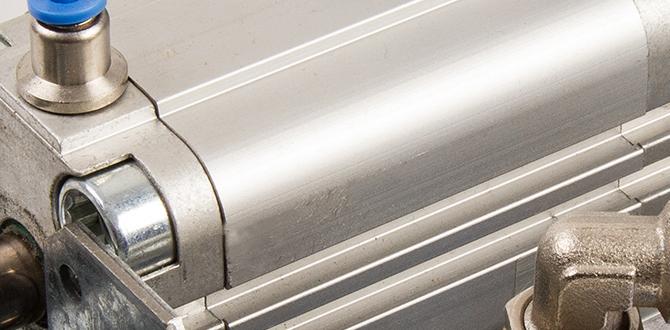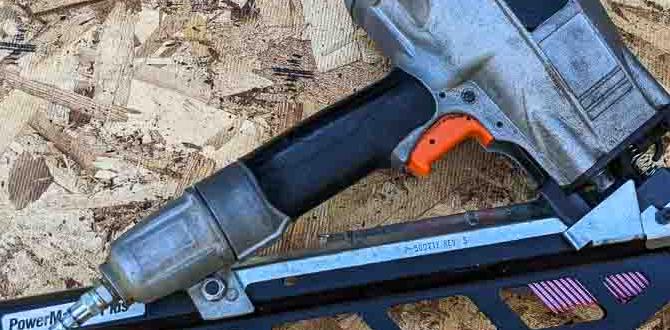To install baseboards with a nailer without damage, choose the right nailer (brad or finish), use the correct nail size and pressure, practice on scrap wood, and aim with precision to avoid marks on your walls or baseboards.
Installing baseboards can seem like a big job, but using a nailer makes it way easier and faster. If you’ve ever struggled with hammering nails straight or accidentally dented your brand-new baseboards, you know how frustrating it can be. A nailer is your best friend for a clean, professional finish. We’re going to walk through everything you need to know, from picking the right nailer to making sure every nail goes in perfectly. Let’s get your baseboards looking sharp!
Table of Contents
Why Use a Nailer for Baseboards?
Let’s be honest, hammering nails one by one, especially for something as long and prominent as baseboards, can be a real chore. It takes time, a steady hand, and can lead to mistakes like bent nails, mushroomed nail heads, or even precious dings and dents on your pristine molding and the wall behind it.
A nailer, on the other hand, is designed for efficiency and precision. It drives nails quickly and consistently, saving you tons of time and effort. Plus, with the right technique, it helps you achieve that seamless, professional look that’s hard to get with just a hammer. It’s a game-changer for DIYers and pros alike!
Choosing the Right Nailer for Baseboards
Not all nailers are created equal, and for baseboards, you want something that’s going to be precise and gentle enough not to damage the molding. The two top contenders are brad nailers and finish nailers.
Brad Nailer vs. Finish Nailer for Baseboards
Brad Nailer: These use very thin, short nails (typically 18-gauge). They’re great for delicate trim work where minimizing visible holes is key. The smaller nail allows for less damage to the wood.
Finish Nailer: These use slightly thicker and longer nails (typically 15-gauge or 16-gauge). They offer a bit more holding power, which can be useful for longer or heavier baseboard pieces.
For most baseboard applications, a 16-gauge finish nailer is the sweet spot. It provides enough strength to hold the baseboard securely to the wall studs without being so large that it causes significant damage or splitting. A brad nailer can also work, especially for very thin or soft moldings, but you might need to be a bit more careful about ensuring a secure fit. Sometimes, using a combination of both can be beneficial, using the finish nailer for structural support and the brad nailer for final, less visible touches.
Other Nailer Considerations
Power Source:
Electric/Corded: Reliable power, but you’re tethered by a cord.
Cordless (Battery-Powered): Offers great portability and freedom, but you need to keep batteries charged.
Pneumatic (Air-Powered): Powerful and lightweight nailers, but require an air compressor and hose, which can be bulky.
Magazine Angle: Baseboard installation often requires getting your nailer into corners and tight spaces. Nailers with angled magazines (like 20 or 21 degrees) make it easier to maneuver into these spots compared to straight magazines.
Essential Tools and Materials
Beyond the nailer itself, here’s a list of what you’ll need to get the job done smoothly and safely:
Your Chosen Nailer: (Brad or Finish Nailer)
Air Compressor and Hose (if using pneumatic): Make sure it’s appropriately sized for your nailer.
Nails: The correct gauge and length for your nailer and baseboard material. (Typically 1 ½” to 2″ for 15 or 16-gauge nails on standard drywall and studs).
Safety Glasses: Absolutely crucial to protect your eyes from flying debris or ricocheting nails.
Work Gloves: To protect your hands.
Measuring Tape: For accurate cuts.
Pencil: For marking measurements.
Miter Saw: For making precise angled cuts (like for corners).
Stud Finder: To locate wall studs for secure fastening.
Caulk Gun and Caulk: For filling gaps and imperfections.
Wood Filler or Putty: For filling nail holes.
Hammer: For gently tapping baseboards into place if needed, and for setting any proud nails.
Nail Set: A tool used to sink nail heads slightly below the surface of the wood, making them easier to fill.
Painter’s Tape: Can be helpful for protecting surfaces or marking tricky areas.
Step-by-Step Guide to Nailing Baseboards
Follow these steps to nail your baseboards like a pro, ensuring a secure fit and a flawless finish.
Step 1: Prepare Your Workspace and Baseboards
Before you even pick up the nailer, make sure everything is ready.
Clear the Area: Remove furniture and any obstacles so you have plenty of room to work.
Inspect the Wall: Make sure the wall surface is smooth and clean. If there are any significant imperfections, address them first.
Inspect Baseboards: Check your new baseboards for any defects or damage. Ensure they are cut to the correct lengths and angles for your room. Dry-fit the pieces to make sure they fit well before nailing.
Step 2: Locate Wall Studs
This is a critical step for a secure installation. Baseboards need to be nailed into studs for the best hold, not just drywall.
Use a stud finder or tap lightly on the wall to locate the studs. Mark their centers with a pencil. Standard stud spacing is typically 16 or 24 inches on center.
Consider electrical outlets and plumbing. Try to avoid nailing directly into areas where you know there are wires or pipes.
Step 3: Setting Up Your Nailer
Proper setup prevents frustration and damage.
Connect Air Hose (Pneumatic): Ensure the hose is securely attached to both the compressor and the nailer.
Set Air Pressure: This is CRUCIAL. Consult your nailer’s manual, but a good starting point for a 16-gauge finish nailer is usually between 70-100 PSI. Too low, and the nail won’t drive in. Too high, and you risk blowing through the molding or damaging the wall. It’s always best to start lower and increase gradually.
Load Nails: Follow your nailer’s instructions for loading the correct size and type of nails.
Safety Check: Make sure you are wearing safety glasses BEFORE loading nails or turning on the air. Never point the nailer at yourself or others.
Step 4: Practice on Scrap Wood
Don’t skip this! It’s the best way to fine-tune your air pressure and get a feel for the nailer.
Grab a piece of scrap wood that’s similar in thickness and density to your baseboards.
Set your air pressure and fire a few nails into the scrap wood.
Nail Sinks Too Deeply/Goes Through: Lower the air pressure.
Nail Doesn’t Sink Fully: Increase the air pressure slightly or ensure you’re pushing the nailer flush against the surface.
Aim for the nail head to sit just slightly below or flush with the surface of the wood.
Step 5: Nailing the Baseboards
Now for the main event!
Position the Baseboard: Hold the baseboard firmly in place against the wall, making sure it’s flush.
Aim Carefully: Place the tip of the nailer directly over where you want the nail to go. For baseboards, aim to hit the wall stud.
Engage the Nailer:
Sequential Trip (Bump Fire): You typically hold the trigger down and “bump” the nose of the nailer against the wood surface to fire each nail. This is fast but requires more control.
Contact Trip (Single Shot): Some nailers require you to press the nose against the surface first, then pull the trigger for each nail. This gives more precise placement.
Regardless of the mode, ensure the nose of the nailer is pressed FIRMLY and FLAT against the baseboard and wall as you fire. This prevents the nailer from “kicking” and leaving a dimple on the surface.
Nail Placement Strategy:
Corners and Joints: Start with nails in corners and at the ends of baseboard sections where they join. This helps hold the piece securely.
Along Studs: Place nails about 16-24 inches apart, directly into the studs.
Blind Nailing (Optional but Recommended): For a cleaner look, especially on the visible face of the baseboard, consider “blind nailing.” This involves drilling a small pilot hole at a 45-degree angle through the baseboard and into the stud, then driving the nail into that hole. This is easier with a brad nailer, or you can use a finish nailer at an angle.
Near Edges: Be extra careful when nailing near the edges of the baseboard to prevent splitting the wood. If you’re using a finish nailer and the wood starts to split, reduce the air pressure and try again, or switch to a brad nailer and finish nails.
Step 6: Dealing with Imperfections
Even with careful work, you might have a nail that doesn’t sit quite right.
Proud Nails: If a nail head is sticking up, use a nail set and a hammer. Place the tip of the nail set on the nail head and gently tap with the hammer until the nail head is slightly below the surface.
Surface Dings: If the nailer left a small dent, you can often disguise it with wood filler or caulk during the finishing stage.
Splits: For small splits, wood glue can sometimes be effective before filling with wood filler. Larger splits might mean you need to replace that section of baseboard.
Step 7: Finishing Touches
This is what makes the job look truly professional.
Fill Nail Holes: Once all the baseboards are nailed in place, fill each nail hole with wood filler or putty. Choose a color that matches your baseboard material, or a general wood filler that can be painted over. Let the filler dry completely according to the product instructions.
Sand (Optional): Lightly sand any raised filler or rough spots.
Caulk Gaps: Apply a bead of paintable caulk along the top edge where the baseboard meets the wall, and at any seams between baseboard pieces or where it meets door frames. This hides any small gaps and creates a smooth transition.
Clean Up: Wipe away excess caulk before it dries. Once the caulk and filler are dry, you’re ready for painting!
Tips for Using a Nailer on Baseboards Without Damage
Here are some proactive ways to ensure you get a clean finish and avoid common pitfalls:
Always Use Safety Glasses: This cannot be stressed enough.
Know Your Material: Softer woods are more prone to splitting and denting. Be extra gentle with them. Hardwoods can sometimes resist nails if the pressure is too low.
Check Nail Length: Use nails that are long enough to securely penetrate the baseboard and into the stud, but not so long that they poke through the other side of the baseboard or into a wall cavity where they aren’t needed. Typically, 1 ½” to 2″ nails are sufficient for standard baseboards over drywall.
Adjust Depth Setting: Many nailers have an adjustable depth setting. This controls how much the nail is driven into the wood. Experiment with this setting during your practice phase to find the sweet spot.
Keep the Nailer Vertically Aligned: Try to drive nails straight into the stud whenever possible. Angled nails are more likely to bend or cause the wood to split.
Don’t Force It: If a nail isn’t driving in easily, don’t keep hammering away with the nailer. Check your air pressure, ensure the nail is correctly seated, or try a slightly better angle.
Work in Sections: Tack a baseboard section in place, then go back and add more nails for a secure hold. This helps prevent bowing or gaps.
Use Painter’s Tape Strategically: If you’re concerned about marring a delicate wall finish, apply painter’s tape along the wall just below the baseboard line before you start nailing. This can catch any accidental slips.
Be Gentle with Trim: The thinner the trim, the easier it is to damage. For very thin or ornate molding, consider using a brad nailer with finer nails and less air pressure.
Common Baseboard Nailing Mistakes and How to Fix Them
| Mistake | Cause(s) | Solution(s) |
| :—————————— | :———————————————————————– | :————————————————————————————————————————————————————————————- |
| Nail Head Proud (Sticking Out) | Insufficient air pressure; nailer not flush with surface. | Use a nail set and hammer to sink the nail head below the surface. Increase air pressure slightly and re-fire if necessary, ensuring the nailer is flush. |
| Surface Denting/Dimpling | Air pressure too high; nailer “kicking” or not held flat. | Reduce air pressure. Ensure the nailer’s nose is pressed firmly and flat against the baseboard and wall before firing. Use a piece of scrap wood with a hole drilled to guide the nailer. |
| Wood Splitting | Nailing too close to the edge; air pressure too high; wrong nail size. | Reduce air pressure. Use slightly shorter or thinner nails. Drill a small pilot hole first. Use a brad nailer for very thin molding. |
| Nails Not Penetrating Stud | Insufficient air pressure; hitting a knot in the stud; incorrect placement. | Increase air pressure gradually until nails consistently sink into the stud. Ensure you’re aiming for the center of the stud. |
| Baseboard Sagging/Not Flush | Insufficient nailing into studs. | Go back and add more nails, ensuring they hit studs. Use a hammer to gently tap the baseboard flush before nailing at that spot. |
| Visible Nailer Marks | Nailer’s safety contact trip mechanism leaving marks. | Ensure the nailer is pressed flush before firing. Some nailers have interchangeable noses or rubber bumpers. Use a nail set and wood filler. |
Frequently Asked Questions About Nailing Baseboards
Q1: What kind of nailer is best for baseboards?
A: A 16-gauge finish nailer is usually the best choice. It offers a good balance of holding power and minimal damage to the molding. A 18-gauge brad nailer can also work, especially for very delicate trim work.
Q2: What size nails should I use for baseboards?
A: For a 16-gauge finish nailer, 1 ½ to 2-inch nails are generally recommended for standard baseboards. For 18-gauge brad nailers, you might use 1 ¼ to 1 ½-inch nails. Always ensure the nail is long enough to go through the baseboard and into the wall stud.
Q3: How much air pressure should I use for my nailer?
A: This can vary, but a good starting point for a 16-gauge finish nailer is typically between 70-100 PSI. Always refer to your nailer’s manual and start on the lower end, increasing pressure gradually while testing on scrap wood until nails sink perfectly.
Q4: How do I avoid damaging the wall or baseboard with the nailer?
A: The key is consistent practice on scrap wood to dial in the air pressure and depth. Always press the nailer firmly and flat against the surface before firing. Avoid firing the nailer while the nose is angled or not fully engaged.
Q5: What if a nail doesn’t go in all the way?
A: First, check your air pressure and increase it slightly if needed. Ensure the nailer is held flush against the surface. If it’s still not sinking, you might be hitting a very hard spot in the wood or a particularly stubborn stud. You can try a second nail nearby or use a hammer and nail set to finish driving it.
Q6: Can I nail baseboards directly into drywall without hitting studs?
A: It’s strongly discouraged. Nails only driven into drywall will not provide a secure hold, and the baseboards can easily sag, pull away, or become damaged over time. Always locate and nail into wall studs whenever possible. Use a stud finder carefully.
Q7: Do I need to fill the nail holes on baseboards?
A: Yes, for a professional finish, it’s highly recommended. Filling nail holes with wood filler or putty hides the fasteners and prepares the surface for painting or staining, creating a smooth, seamless look.
Conclusion
Using a nailer to install baseboards is a fantastic way to achieve professional results with less effort. By choosing the right tool, understanding your settings, and practicing a little, you can easily nail your baseboards in place without a hitch. Remember to prioritize safety, measure twice, and fire once. With these tips, you’re well on your way to transforming your rooms with perfectly installed baseboards. Happy Nailing!


